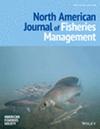新的环太平洋地区大鳞大麻哈鱼遗传种群鉴定(GSI)国际标准基线
IF 1.4
4区 农林科学
Q3 FISHERIES
引用次数: 0
摘要
目标遗传种群鉴定(GSI)可以成为渔业管理的有效工具,但为地理分布广泛的物种制定参考基线可能具有挑战性。几十年来,针对大鳞大麻哈鱼(Oncorhynchus tshawytscha)的混合种群渔业一直利用各种遗传基线进行 GSI 分析,但随着技术的进步,基因分型的效率不断提高,这些基线已基本过时。因此,我们的目标是:(1) 利用多种来源的现有数据,为大鳞大麻哈鱼的整个自然分布区创建嵌套的基因型数据基线;(2) 评估这些嵌套基线在对混合物比例或个体鱼类种群鉴定进行精确的分级 GSI 方面的实用性。结果我们证明,多层分配方法可在第一层(广泛范围,包括三个沿海报告组;平均准确率 97.8%)和第二层(精细范围区域报告组;平均准确率高达 97.7%)提供高准确率。现实的混合物模拟表明,这种多层次方法可为太平洋地区的几种常见混合种群渔业应用提供高效的 GSI 结果。结论与以往的任何应用相比,这种新的 SNP 基线和多层次分配方法为大鳞大麻哈鱼提供了最全面的全范围 GSI 基线,并可为 GSI 目的提供高精度的估计值。本文章由计算机程序翻译,如有差异,请以英文原文为准。
A new, standardized international Pacific Rim baseline for genetic stock identification (GSI) of Chinook Salmon
ObjectiveGenetic stock identification (GSI) can be an effective tool for fisheries management, but development of reference baselines for species with broad geographic distributions can be challenging. Mixed‐stock fisheries for Chinook Salmon Oncorhynchus tshawytscha have utilized GSI analyses for decades with various genetic baselines, but these have largely become outdated with advances in technology that enable more efficient genotyping. Thus, our goals were to (1) create nested baselines of genotypic data for Chinook Salmon throughout their entire natural range using existing data from multiple sources and (2) evaluate the utility of those nested baselines to conduct accurate hierarchical GSI of mixture proportions or the stock identification of individual fish.MethodsIn this study, we compiled a large genetic baseline of single‐nucleotide polymorphism (SNP) markers for 389 populations that encompass the entire geographic range of Chinook Salmon. We used cross validation and realistic mixture simulations to test the accuracy of the baseline in generating GSI estimates.ResultWe demonstrated that a multi‐tiered assignment approach can provide high accuracy at both tier 1 (broadscale, with three coastwide reporting groups; 97.8% mean accuracy) and tier 2 (fine‐scale regional reporting groups; up to 97.7% mean accuracy) levels. Realistic mixture simulations showed that this multi‐tiered approach can provide highly effective GSI results for several common mixed‐stock fisheries applications in the Pacific Ocean.ConclusionThis new SNP baseline and the multi‐tiered assignment approach provide the most comprehensive rangewide GSI baseline for Chinook Salmon over any previous application and enable highly accurate estimates for GSI purposes.
求助全文
通过发布文献求助,成功后即可免费获取论文全文。
去求助
来源期刊
CiteScore
2.60
自引率
18.20%
发文量
118
审稿时长
2 months
期刊介绍:
The North American Journal of Fisheries Management promotes communication among fishery managers with an emphasis on North America, and addresses the maintenance, enhancement, and allocation of fisheries resources. It chronicles the development of practical monitoring and management programs for finfish and exploitable shellfish in marine and freshwater environments.
Contributions relate to the management of fish populations, habitats, and users to protect and enhance fish and fishery resources for societal benefits. Case histories of successes, failures, and effects of fisheries programs help convey practical management experience to others.

 求助内容:
求助内容: 应助结果提醒方式:
应助结果提醒方式:


